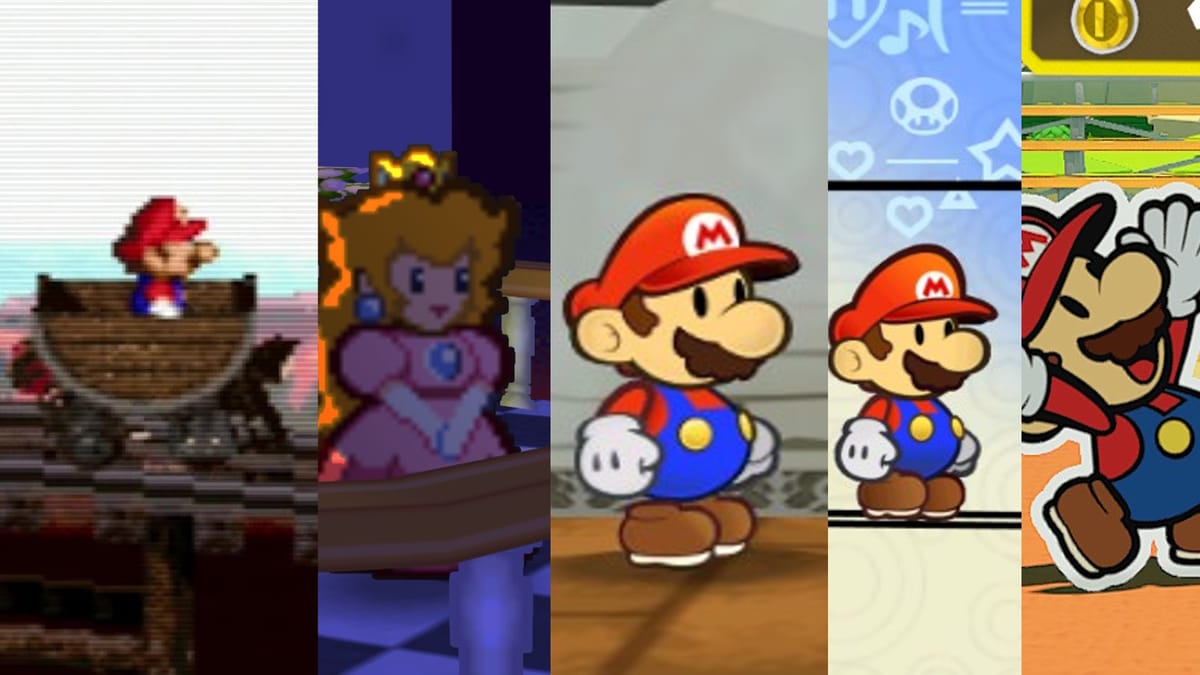
I’ve been thinking about Paper Mario for… a long time. Originally this article was going to be a massive series of retrospectives on each game in the series, from Mario RPG leading up to Origami King, and a look at what could have been in Bug Fables. Obviously, that isn’t what you’re reading right now, and there’s a good reason for that. It was bloated, overly long, and didn’t have much to say in each piece. I tried to structure it like my Psychonauts retro review when it came to Game Pass; a walk through the game analyzing each significant portion leading up to a conclusion tying it all together. I also tried to give each game a score for some reason, and in all honesty scores shouldn’t be the be-all-end-all that they are nowadays, but that’s besides the point. I wanted to add something to the conversation about Paper Mario, and instead of doing that I repeated points others like Arlo and Chuggaconroy in the YouTube space have already said a million times over. This is going to be shorter (kinda), more concise, and hopefully more interesting as a result. So, here it is: something new.
Paper Mario has always been trying to offer a specific type of experience, and it’s not turn based battles. But I’m getting ahead of myself. The first Mario game in the RPG genre was the aptly named Super Mario RPG: Legend of the Seven Stars. This is a fairly traditional RPG on the Super Nintendo, with a party, leveling up, and equipment, but it introduced a few things that became core to later games. These are: Timed Hits, Puzzle Platforming, and First Strikes. If you boil down every role playing game in the Mario franchise, you’ll find these three core ingredients.
I think it’s safe to say that this is what Nintendo sees as Paper Mario’s identity. The main Mario games are about the joy of movement – the levels, objectives, and everything else are just excuses to get you to use the full breadth of the plumber’s moveset in interesting and fun ways. From a game design perspective, what made Mario RPG unique and interesting was the interactivity and excitement it brought to normally static turn-based gameplay.
Exploration and platforming are also very important here, as while you could increase characters’ stats by leveling up, you needed to find hidden flowers to increase the party’s maximum FP, which is used in battle to perform special moves. This is something I wish would return more concretely, but these flowers are essentially swapped out for badges in later games. Still, this makes it a great “baby’s first RPG” because it takes what makes platformers fun and translates that into turn-based battles.
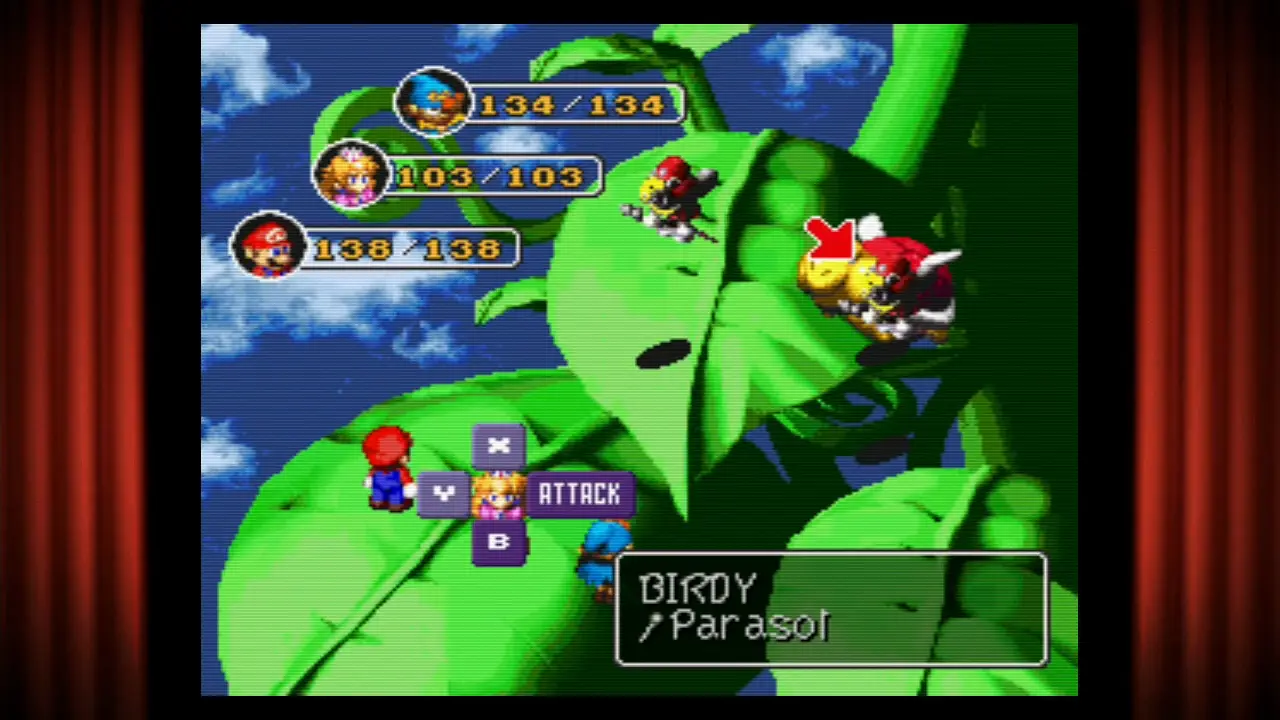
Of course, it also helped that the game had a wacky sense of humor, and, despite a relatively serious main plot, it often felt like you and your Super Nintendo cartridge were in on a joke together. “Getting everyone’s wishes back is important, but isn’t this all just a bit silly?” the game would say, tongue firmly in cheek. This serves a dual purpose for the target audience (children, mainly boys). It allows them to both get invested in the stakes and completely disregard them when it suits the player. It’s like kids playing with action figures, you can take play both incredibly seriously yet make jokes at its expense at the same time. The fourth wall is fully permeable here; solid when you want it, gone when you don’t. Remember this particular dynamic, it’s going to be very important later.
Moving forward, it was time to make a sequel, but Nintendo and SquareSoft had a little spat over Final Fantasy moving to PlayStation. The sensible thing to do would be to understand that they had certain ambitions for the series that the N64 just couldn’t meet, but it’s the 90’s and we want to be petty so Intelligent Systems will develop the next Mario RPG. I kid obviously, but IS truly ran with the core of Seven Stars and turned it up to eleven to make it even more Mario. Those main ingredients and the style of humor remain, but equipment and party management are out. In their place are Badges and Partners, both offering a wealth of player expression and customization.
While Mario still levels up, allowing you to increase one of three stats, the main way you grow stronger is through Badges. Badges can be bought from shops, but for the most part you’ll be finding them scattered around the world, earning them by completing puzzles or platforming challenges. On top of successfully integrating exploration and battles (you become stronger the more you discover), these can completely change how you approach battles. You could equip a badge that grants Mario the ability to use a more powerful jump in battle at the cost of FP, a badge that regenerates his health every turn, a badge that makes his overworld spin move go faster and make enemies dizzy, or even a badge that boosts his attack when HP is low. Just about every badge can have a use if you’re creative enough, the only limit is how much BP Mario has to equip said badges.
Mario is the star of the show here, but he can share the spotlight with a few friends. Well, one at a time, at least. Partners in battle are essentially specific offshoots of Mario’s repertoire. Your first pal, Goombario, takes jumping to the extreme with headbonks that can hit one enemy multiple times or an entire group of foes one after the other. Kooper, meanwhile, prefers to take the hammer style, able to attack grounded foes without fear of spikes. Each partner has a move or two that makes them unique, like Bombette’s explosions and… whatever Sushie does with her mouth, but that’s the basic gist of partners.
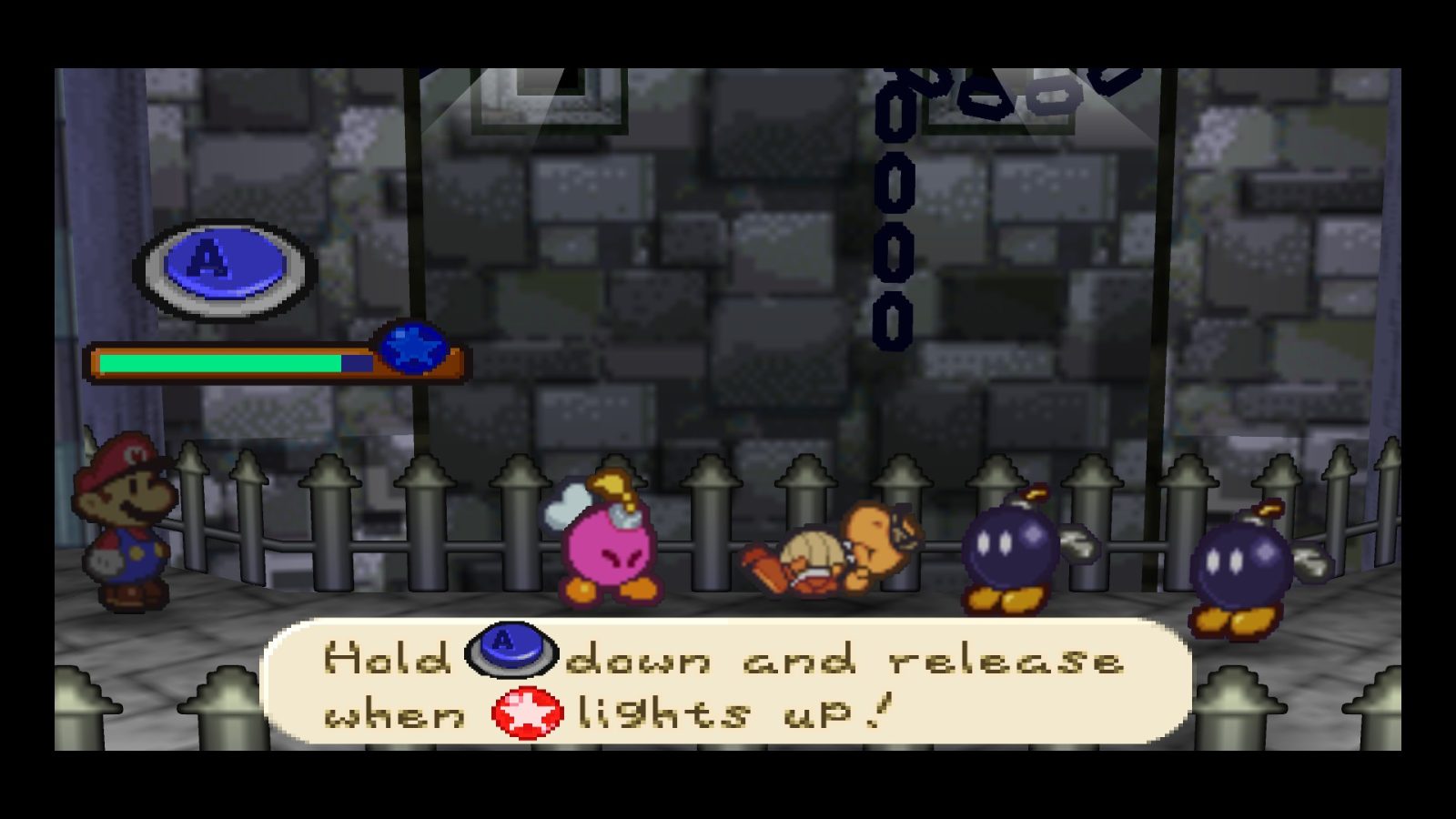
Outside of battle, though, is where Partners really shine. Each has a unique ability that allows you to traverse more of the world, with the exception of Goombario who’s Tattle ability will tell you about a person or location, often giving you hints. Kooper can hit distant switches or grab items, Bombette can blow up certain walls, Lady Bow can make Mario invisible and invincible while standing still, Watt can illuminate the two dark rooms in the game, Parakarry can lift Mario across gaps he can’t jump on his own, Lakilester can carry him over hazards like spikes and lava, and Sushi can carry him across water. Look, there’s a lot of carrying going on, but you get the idea. Partners give the player more verbs for specific contexts, making you see the world in a slightly different way and encouraging you to explore thoroughly and go back to previously inaccessible locations.
The best example of this is Toad Town, the main bastion of civilization you’ll return to between each chapter. All roads lead to Toad Town as they say, and as you befriend more partners you’ll be able to explore more nooks and crannies of the city. Each time you return, most citizens will have new dialogue including side quests for you to do. It really makes the Mushroom Kingdom feel more like a place than it’s ever been since.
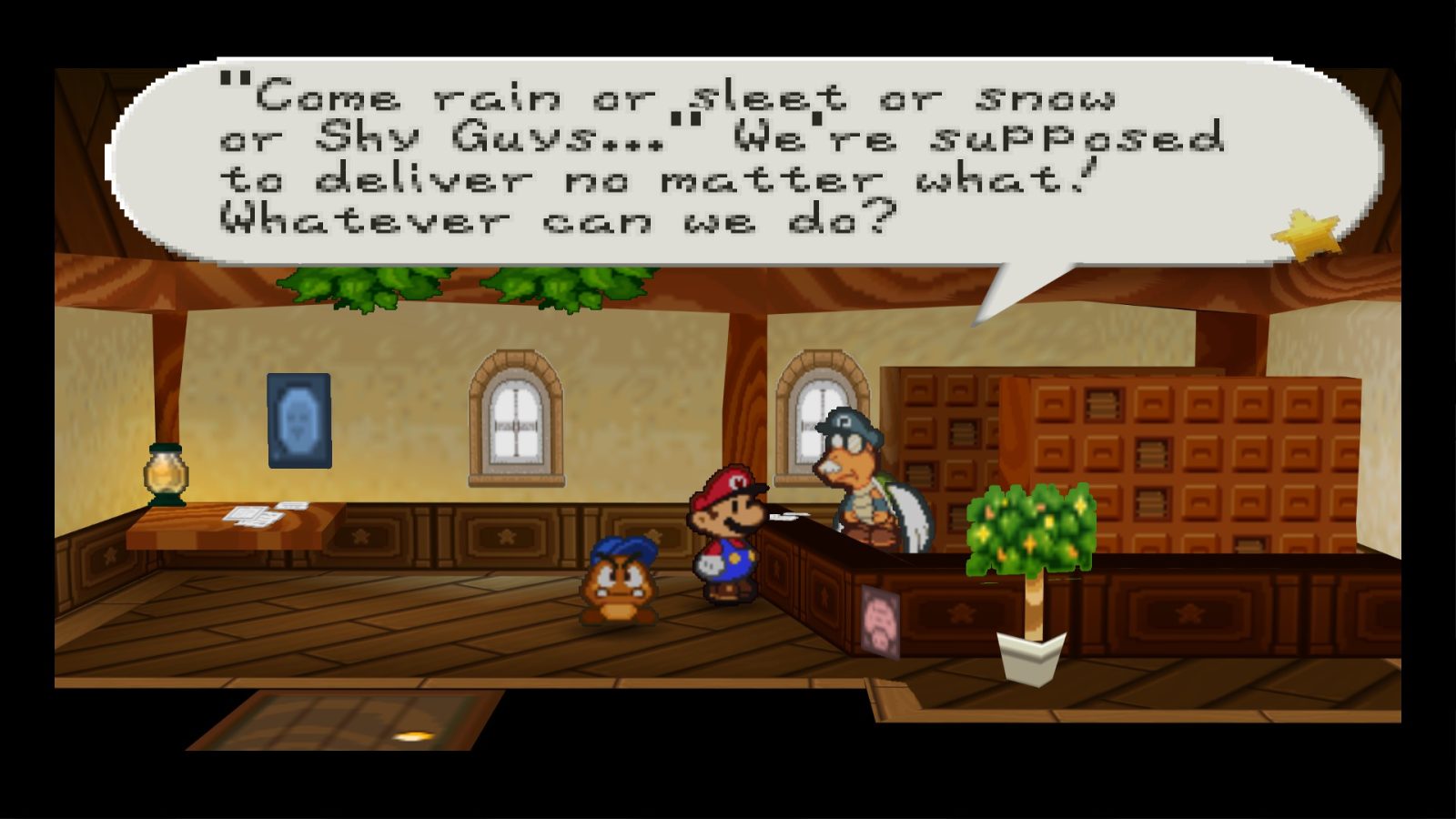
However, I don’t believe that was the developers’ intentions here. Just like with partners, the world exists to facilitate gameplay first and story or atmosphere are more incidental. Partners barely have personalities because they are only given the minimum amount to convey how they act in the field and in battle. The characters in towns and areas across the world have unique designs and personalities so you can more easily remember them for whatever function they serve (i.e. quests, cooking, shopping, etc.). Tas T. is a clever pun, but mostly it serves to stick in your mind that that is the character you go to to cook items. Outside of those NPCs, others exist almost purely for jokes. I believe that a lot of the charm that fans love in the first two to three Paper Mario games (depending on who you ask) is actually an unintended side effect of the games’ design ethos.
Before we move on to the fan favorite game, let’s discuss what I proposed were the three core elements of a Mario RPG. While Timed Hits aren’t available initially, Mario does gain access to them a bit after clearing the prologue. Basically every action you take in battle, save for items, uses this mechanic by having you press A to deal more damage, hit multiple times, or block. There are also new types of timed hits, such as rapidly pressing A, holding the control stick in a direction then releasing, or pressing a sequence of buttons. It’s a great evolution of the concept, though the timing can get off when playing on a virtual console such as the Wii.

The N64 title ups the ante with puzzle platforming too, though focusing more on solving puzzles with partner abilities than making tricky jumps. It’s a smoother experience that presents long term challenges in addition to moment-to-moment gameplay. First strikes are likewise expanded on; Mario can jump on, hammer, or use a partner’s ability to initiate battle and deal damage right off the bat. Conversely, if an enemy hits Mario first they’ll get the upper hand, adding some risk and reward to the system. Overall, Paper Mario is a great step up from Mario RPG, providing new spins on old mechanics as well as building on the potential for player freedom and expression. It does, however, retread the basic plot for the SNES title, something other games are guilty of as well.
Paper Mario: The Thousand Year Door is a further refinement of the mechanics seen in the previous game rather than a true evolution. It instead focuses on adding a few new traversal techniques and differentiating partners a bit more. Partners feel more varied and flexible, even if they’re mostly just copy/paste the same abilities from before. While they still don’t do much plot-wise outside of their respective chapters, they have a whole lot more personality. Whoever you have out at the time will comment in cutscenes, giving whoever you like a bit more screen time along with a variety of jokes.

Speaking of humor, while TTYD has it in spades, the overall tone dips a bit darker than other games in the series. Everyone and their grandma has mentioned the noose and gallows at the center of Rogueport, but it’s not just the setting that’s changed. The stakes feel more drastic as well, though I would hesitate to say they’re higher. While largely a comedic force, the X-Nauts do pose a tangible threat to the world and, more specifically, Princess Peach since they want to use her as a vessel for their dark goddess.
You may be noticing a pattern so far. Despite the change in context and a few gameplay tweaks, these three games essentially follow the same formula. Something involving Peach happens, Mario goes off to fix things by collecting seven star shaped objects, and everything gets fixed by the end. The most interesting changes are ones that more closely connect Mario’s traditional platforming with the RPG mechanics, which is what TTYD does better than other games in the series.
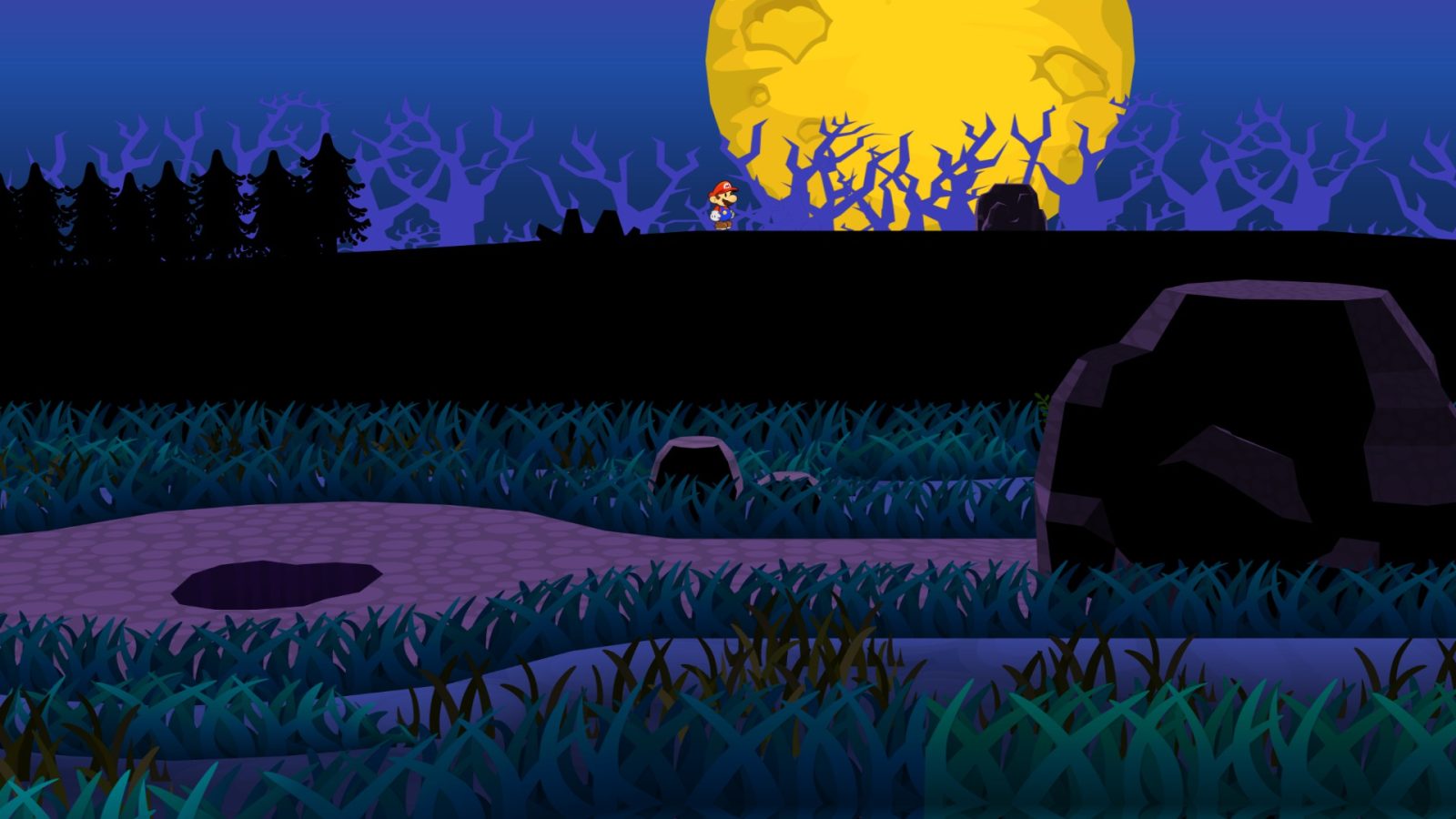
This is the first game to really take the paper aesthetic and run with it for gameplay, while still keeping it incidental in terms of humor and dialogue (remember that for later). Throughout the game, Mario will be cursed by spooky treasure chests to… turn sideways and move through gaps, turn into a paper airplane or boat, or roll himself into a cylinder. The joke is that all these curses are beneficial. It’s a fun mechanic that, along with new partner abilities, has you looking at the environment differently. You can’t use these in battle unfortunately, but you can use them to avoid encounters you don’t want to enter.
While I still think adding a new party member every chapter is not a great idea, Thousand Year Door does give these characters slightly more spotlight and allows their abilities to further differentiate them in battle. For example, Flurrie can blow obstacles out of the way on the field and blow enemies out of battle. Again most abilities have exact counterparts from 64, but it’s a small step forward.
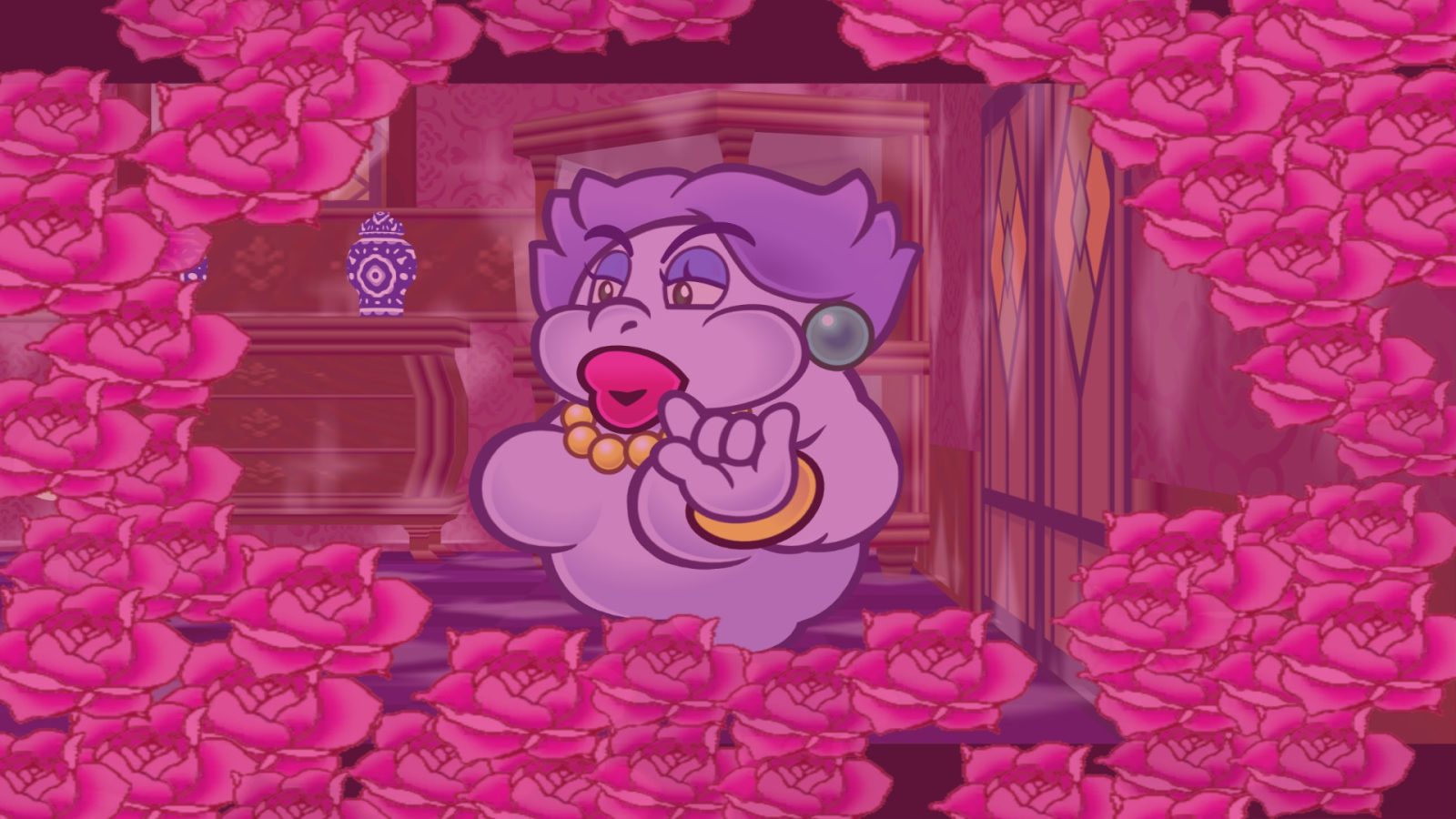
Speaking of steps forward, Super Paper Mario does not take any. Instead, it throws basically everything out the window for a puzzle platformer and light RPG/party mechanics. Some of you may be questioning one of my stated “core pillars” of a Paper Mario game right now, seeing as First Strikes here boil down to just hitting an enemy before they see you, but this will lead into my actual point about the difference between classic and modern Paper Mario. Sit tight, we’ll get there.
In Super, the focus is squarely on Puzzle Platforming, though Timed Hits still play a part in combat and platforming. You can hold 2 to launch higher after bouncing on a foe, but you can also shake the Wii remote after a bounce to perform a trick, increase your score, and thus gain levels more quickly. It’s an alright way to keep some RPG mechanics, but again this is much closer to a 2D platformer.
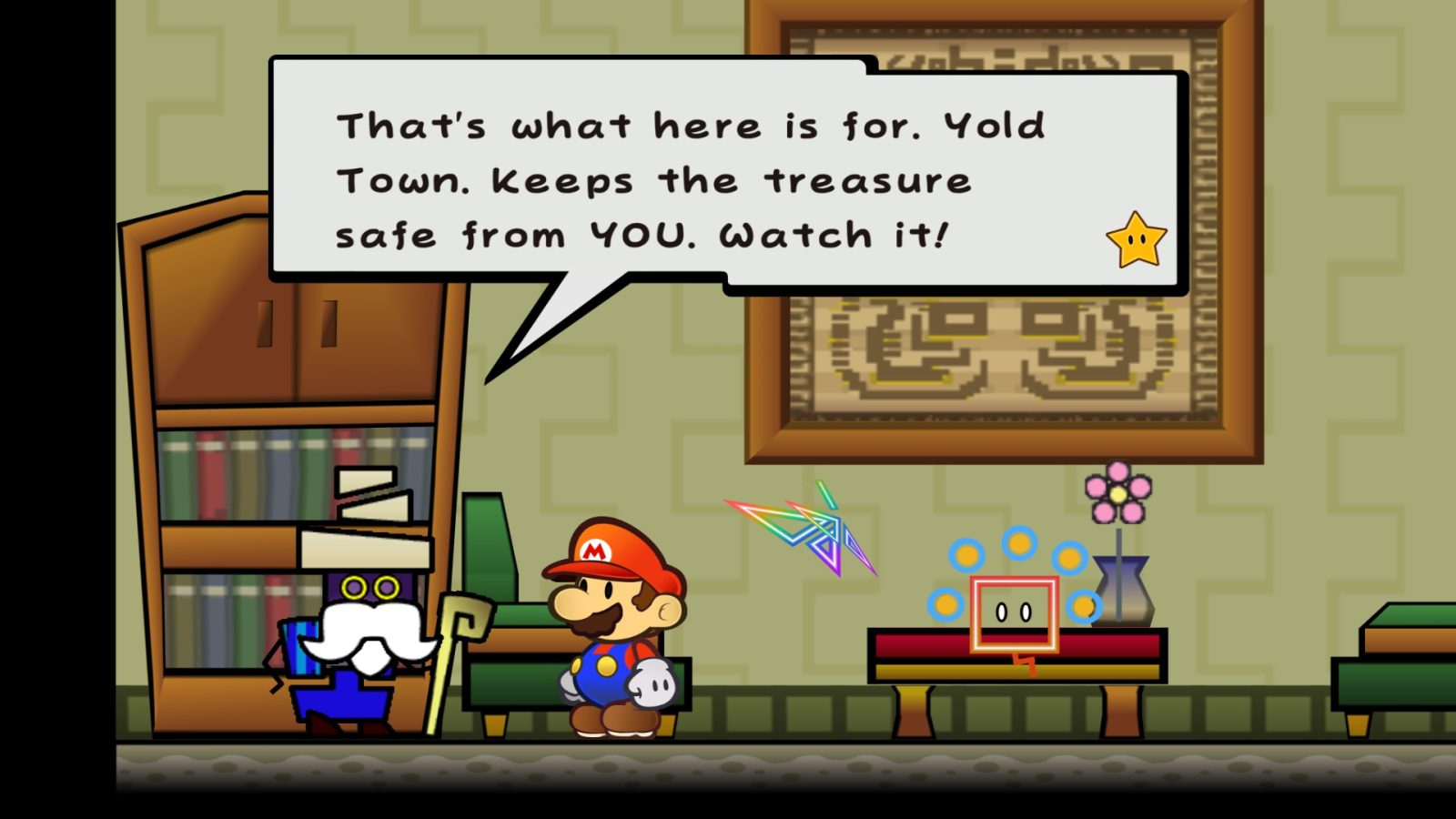
Mario still has a party in this game, and they now consist of two separate categories: characters and pixls. The characters you play as are Mario, Peach, Bowser, and Luigi. Each character has different abilities; Mario can flip from 2D to 3D, giving you a new perspective on levels to solve puzzles, Peach can float to reach normally inaccessible areas, Bowser has high attack power and can breathe fire, and Luigi can… jump higher. Mario is the star here, as other characters’ abilities are situational at best, but what about the pixls? These beings follow Mario around and can grant him their powers such as a bomb, hovering slightly above the ground, or examining things by pointing at them with the Wii remote. Honestly, Super is closer to a Zelda game than a Mario game in more ways than one.
Which brings us to the story. Super Paper Mario genuinely has one of my favorite stories in games. It’s shockingly heartfelt and tragic, you get the feeling someone really wanted to tell this tale. It would still be good without Mario characters, but having them in it only serves to enhance the feelings. You don’t expect this level of theming and intentionality in most Nintendo games, let alone Mario, and the absurdity of having a mute plumber at the center of everything paradoxically makes things all the more serious. It might look ridiculous on the outside, but it is so genuine that you might just believe it when Peach and Lugie “die” near the end of the game. I certainly did as a child (though I also was devastated by Goofy’s death in Kingdom Hearts II, so take that with a grain of salt).

Super is where what I’m calling the Classic era of Paper Mario ends and the Modern era begins. We still retain the core pillars moving forward, but it’s clear something is very off here. Let’s see if you can spot the difference.
Paper Mario: Sticker Star is the absolute lowest point in the series. It’s not glitchy or poorly crafted, far from it, but it fundamentally misuses its central gimmick and takes only the blandest, least interesting parts of the Mario universe for its setting. Sticker Star keeps the level based format from Super, while more equally weighing puzzle platforming and combat. Battles are familiar from previous games, being turn based once more and requiring you to press A at certain times to deal the most damage. You can also hit or jump on an enemy in the field to get the first turn, which means we have all three pillars back. So, in Nintendo’s eyes, this is basically the same kind of game as the first three, right?
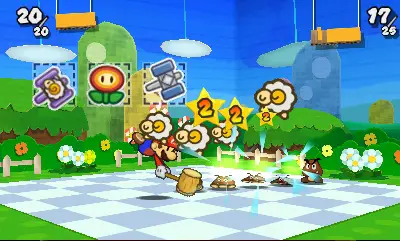
This is where I beg to differ. Despite being the focus of the game, stickers are part of what makes Sticker Star far less engaging than its predecessors. Almost every puzzle in the game comes down to having the right sticker to place in the right spot. Need a windmill to spin? Put a fan sticker on this tree stump. Want to get into the desert? Well you better have a poison mushroom handy to match these hieroglyphics that look exactly like the super mushroom glyph. What? You don’t have one of those things? Well, backtrack through the game and get it.
Part of what makes puzzles fun is thinking about it, then putting your solution into practice immediately. These are barely puzzles – in most cases you’ll know what you need right when you see the puzzle – and the act of solving lies in finding wherever you left that object when you first saw it several hours ago. Exploring could be fun since health (and attack) increases are collectables in the world once again, but most of them just drop from bosses and those that don’t are behind the game’s signature sticker gating. It’s not fun or brain teasing, it’s just busy work.
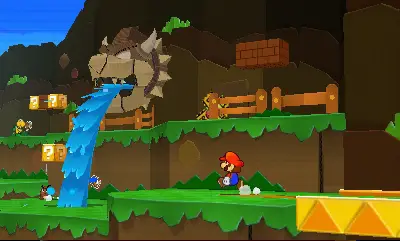
The same can be said of the battles. Instead of a normal command menu, Mario uses stickers stored in his sticker book to attack. This could be an interesting mechanic (though Nintendo hasn’t figured out how after three games), but since stickers are gone after use and there’s no reward for battles other than coins and more stickers, fighting is essentially pointless. Even bosses are basically extensions of the game’s “puzzle solving” with a singular sticker required to win.
I don’t need any tangible reward in games, often the fun of play is its own intrinsic reward, but Sticker Star misses the mark with incredibly boring timed hits. All you need to do for every type of attack is press A when the game tells you. No more tilting back for hammer strikes, or pressing a combination of buttons in sequence, just A. That could also work mechanically – strip out all the fluff and really get at what makes Timed Hits fun, giving a more tactile sensation to normally passive actions. Mario RPG did this, with the interactiveness coming in figuring out when to hit the button and the cool animations. However, attacks in Sticker Star will do fine enough damage without your input, and the animations for these moves are so uninteresting that I’d rather laugh at Mario flubbing than succeeding.
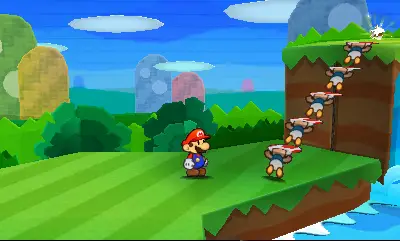
The whole game is just so bland. There’s no memorable dialogue or characters, just jokes about how they’re all made of paper and how that is… apparently supposed to be funny. But the worst part of Sticker Star is that I don’t feel like anyone cared about making this game. I’m sure in reality everyone cared, there are cute details and it can be a funny game, but it’s hard to feel that in the final product. The story and writing aren’t interesting like Super, the combat isn’t enjoyable or customizable like 64 and Thousand Year Door, and Mario in an RPG hasn’t been novel since 1996. I don’t even feel like stickers are thoroughly explored as an idea or mechanic. The game is just… there, merely a product you can purchase because you like Mario.
This is the core of what I think is missing from modern Paper Mario: sincerity. I don’t feel the love and craftsmanship Nintendo normally puts into their games from modern Paper Mario. Sure, they may have the same mechanics, the same focus on humor, and the same art style, but each game from here on out lacks that intangible genuineness that made me fall in love with the series. The fourth wall isn’t permeable here, it’s just gone.

Color Splash is better than Sticker Star in every way (though I’m not a fan of the white outlines), however I still wouldn’t call it good. While I finished Sticker Star and the next game in the series, Origami King, I just couldn’t bring myself to do so here. Battles actually have slightly more of a point now, allowing you to work towards paint capacity upgrades, but they’re so much slower now that you have to paint cards before playing them, unlike stickers. Thankfully the restrictive puzzle solving is improved, but boss fights still suffer from having a single, very specific solution.
Honestly I’m having trouble finding things to say about this game. Sticker Star was at least interesting in how much of a disaster it was, but Color Splash is just boring. There’s still no characters or story to get invested in, battles are better but still not fun, and while the paper aesthetic looks great in HD, I can’t remember any memorable locations or character designs. The only engaging thing about the game is that Toads are literally getting the color sucked out of them in an oddly dark twist, but that macabre idea is played entirely for laughs. If the game is constantly falling over itself to make jokes at its own expense, it’s hard to feel anything. We’re still missing that sincerity that made the classic games as beloved as they are.
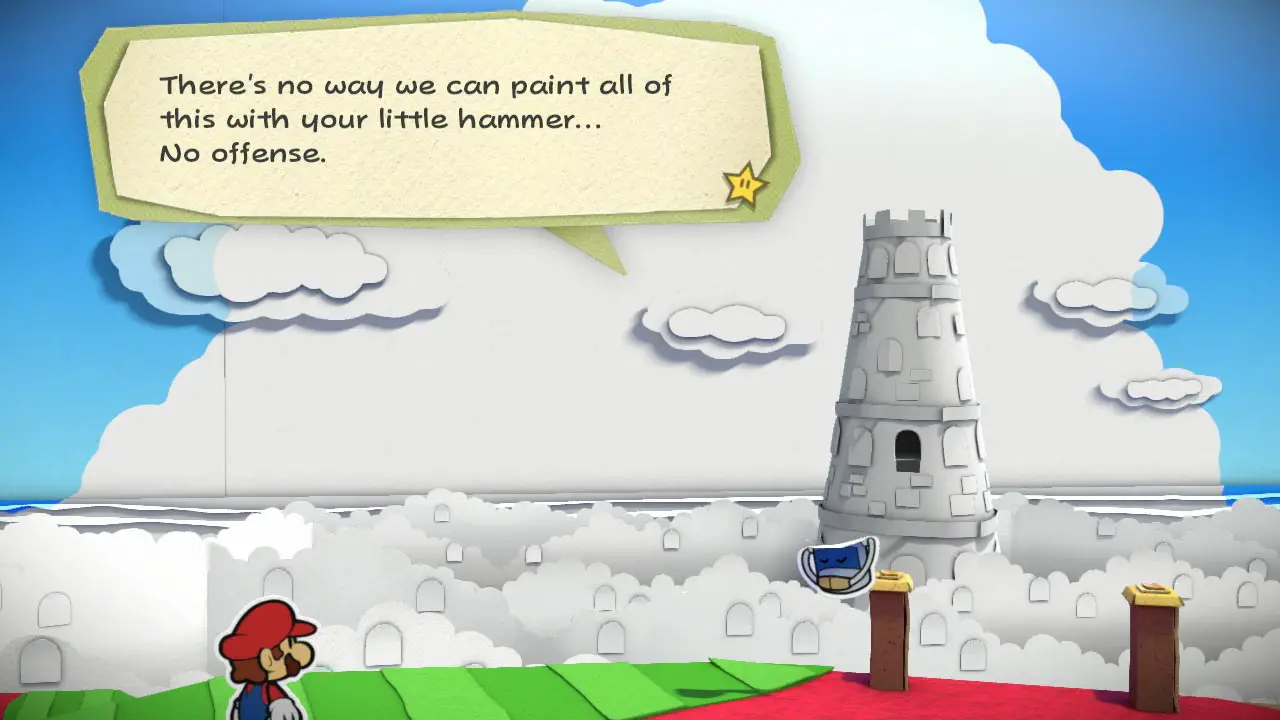
Finally, we come to Origami King, which I reviewed back in 2020. To summarize, it is by far the best of the modern games, however, while it is hilarious, I still found it bland and uninteresting. It focuses a lot on getting that paper aesthetic to apply more to the environment, but doesn’t have a single interesting area to its name. You’ve just got the basic Mario grassland, desert, and sky worlds. Shogun Studios is the coolest for sure, but it still somehow feels like a typical Edo period village despite being a creative hub.
The combat is also a step up from Color Splash, though you can only polish something inherently flawed so much. The spinner style of battles does focus more on puzzle solving, but it leads to every single fight feeling exactly the same. Even going back to the game for this article, I got bored after one or two encounters and just used my virtually unlimited number of coins to have the game solve the puzzles for me.
What’s strange is the game does have a more fun and involved form of combat in hitting paper mache foes on the field, even incorporating puzzle solving with each encounter being unique and having you fight multiple baddies at once. While Mario doesn’t gain any new moves throughout the game (we haven’t had partners in a long time after all), the enemies control the pace here, requiring you to react in the right way at the right time. It successfully captures what made Mario RPG fun in the first place, but in a new and interesting way. Still, these kinds of encounters are few and far between, making you trudge through the turn-based travesty for more than half of the game.
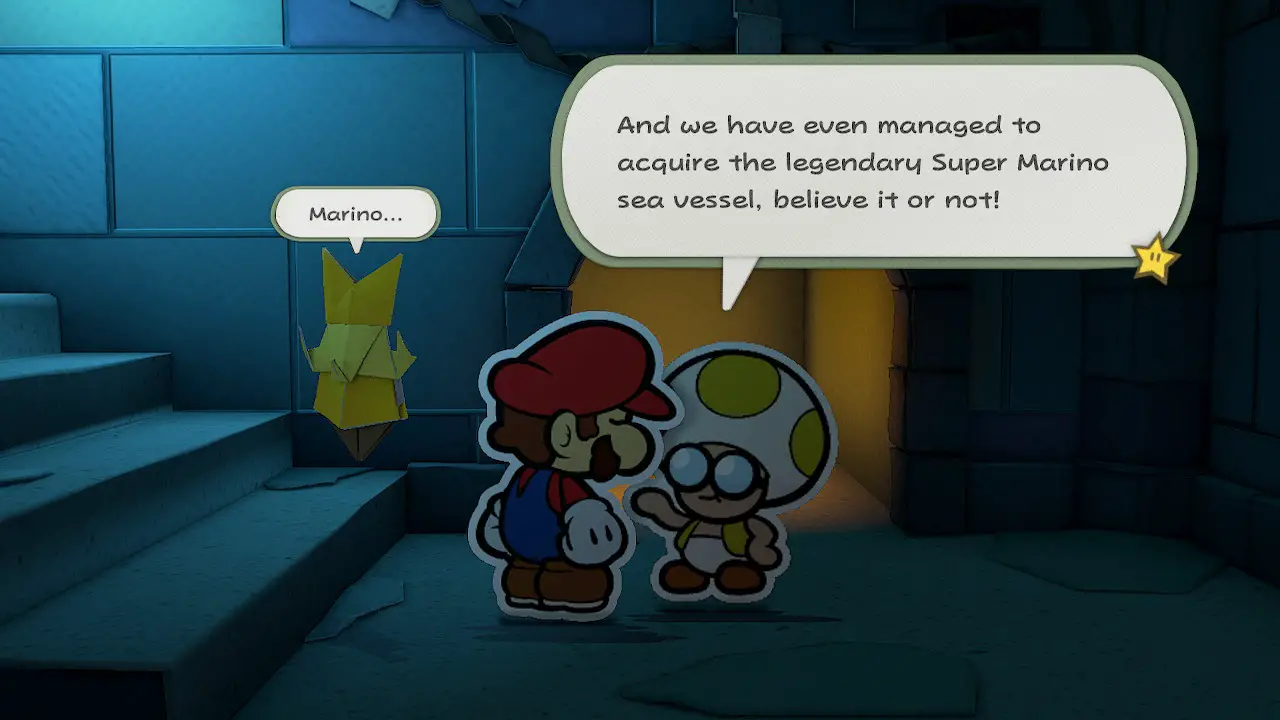
I think by now I’ve proved my point, but let’s take a look at other games that have similar mechanics to the original games and keep the heart and soul of them alive. Of course, Bug Fables is the first game to come to mind and, if you haven’t played it yet, go rectify that. It’s fantastic and actually solves a lot of my issues with 64 and TTYD like having too many party members and not enough spotlight on any of them while still having the same level of exploration. Cris Tales takes a bit more inspiration from Chrono Trigger, but keeps timed hits as well as the 2D characters in a 3D world style. It also adds some great time travel puzzles (both in battle and out of battle), with each section of the story having multiple outcomes. Finally, there’s the upcoming Sea of Stars. This borrows from both Chrono Trigger and Super Mario RPG to create a very interesting and difficult turn-based system. From the demo, combat is quick and deadly, with timed button presses basically being a requirement to survive and defeat your opponents promptly. It’s got some great music and pixel art, and I can’t wait to play it.
In the time it took to write this (which was a loooooooooong time), Nintendo has also announced a remake of the game that started it all: Super Mario RPG: Legend of the Seven Stars. I’ve grown to really love the simplicity of that original game along with its quirky, slapstick humor, and I’m looking forward to revisiting it despite only experiencing the original a year or two ago on the SNES Classic. My biggest complaint was the art style and being a bit too easy, and from the trailer this remake easily fixes one of those, with Peach and Mario looking as adorable as ever in their chibi forms. Hopefully there’s new things to discover along with revisiting the old, but we’ll have to wait and see. I assure you Gaming Trend will be covering it.
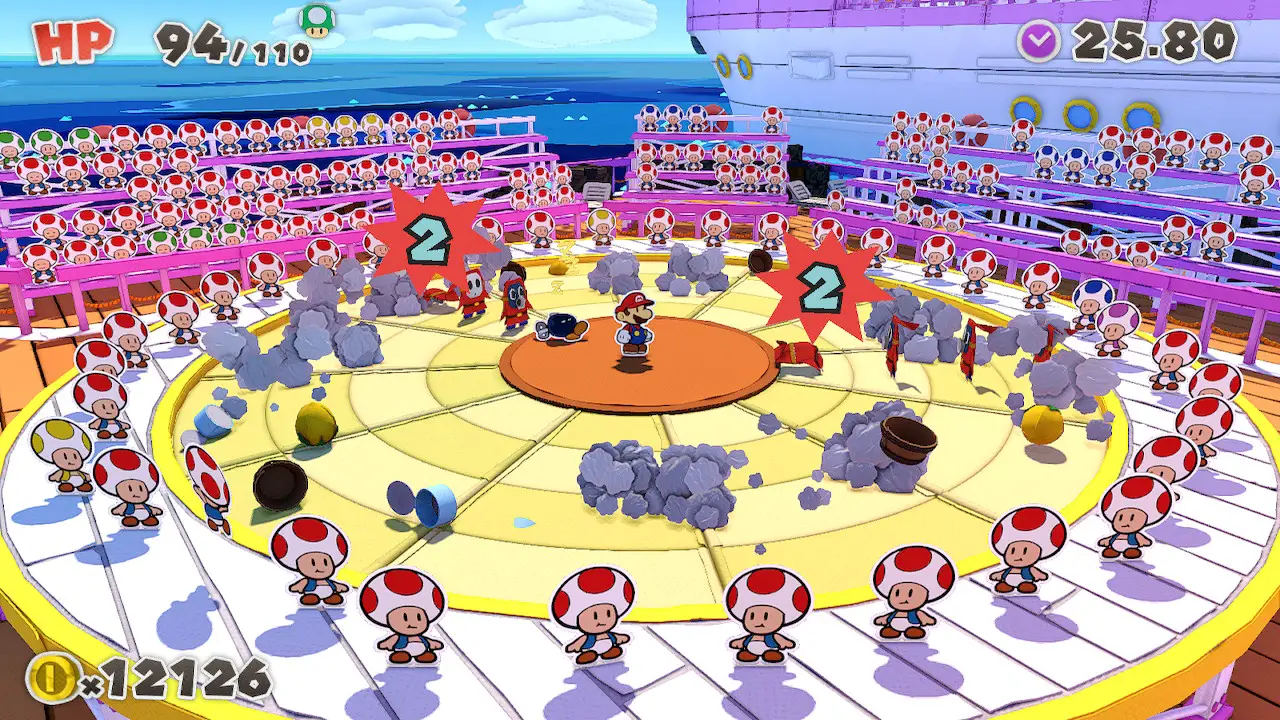
At this point, I’ve come to terms with the fact that the Paper Mario I grew up loving is never coming back. I’ll still keep up with the series, but I’m more excited about games keeping the spirit alive. There’s an infinite amount of interesting places to take the core ideas with new, genuine stories and characters. While I am heavily critical of Nintendo (especially in terms of accessibility and game preservation), it comes from a place of love, not for the company itself, but for the art and the people who made it. If those same people don’t want to make new games in the old style, that’s perfectly fine – I respect their creative choices even if I think they’re misguided in execution and lack that touch of sincerity.
While Paper Mario is no longer to my tastes, I can still find exactly what I’m looking for elsewhere. Thanks indie developers, I hope I can join your ranks someday. Hopefully Nintendo begins to see just why we loved these early games and can recapture the magic. You don’t need to stick with the turn-based format to make Paper Mario as beloved as it used to be, but without taking the world and characters just a bit more seriously, without allowing players to engage with and care about the game, the series will remain like a cardboard paper tube: hollow.
